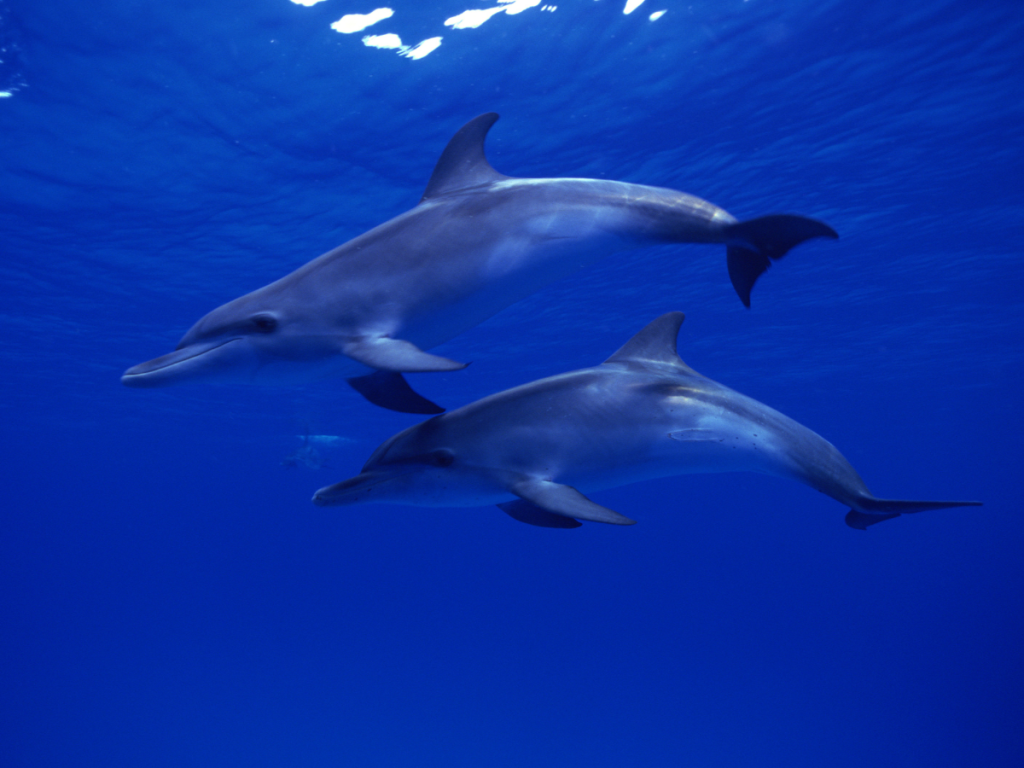Bottlenose dolphins can be found in a range of water temperatures, from tropical to temperate, ranging from 50-90 degrees Fahrenheit. They can be found in the Pacific Ocean from northern Japan to Australia, Southern California to Chile, offshore in the eastern tropical Pacific, and as far west as Hawaii.
In the Atlantic Ocean, they can be found from Nova Scotia to Patagonia and from Norway to the tip of South Africa. They are particularly common along the coast of the United States, from Cape Cod to the Gulf of Mexico.
This is just one of many things you need to know about bottlenose dolphins. Let us take a look at some of their unique characteristics.
Characteristics Of Atlantic Bottlenose Dolphins
- Anatomy
The Atlantic bottlenose dolphins are known for their intelligence and friendly nature. Their name is based on their distinctly short, narrow snouts. Their curved mouths give them a smiling appearance.
These dolphins can grow six to twelve feet in length and weigh between 300-1400 pounds, making them the largest beaked dolphins. It is interesting to note that females can be larger than males.
Bottlenose dolphins have a light to slate gray color on their backs, fading to pale gray or pink on their bellies. They have long, backward-curving dorsal fins and curved tail fins with a deep notch in the middle. They have sleek bodies and pointed pectoral fins. As mammals, they do not have gills; they have lungs and breathe through their blowholes.
- Family
The Atlantic bottlenose dolphin is a member of the genus Tursiops of the Delphinidae family, which also includes other oceanic dolphins.
- Conservation Status
While the Atlantic bottlenose dolphin is not considered an endangered species, human activities such as habitat degradation and pollution impact their coastal populations. They are protected under the U.S. Marine Mammal Protection Act.
- Diet
Atlantic bottlenose dolphins live in various aquatic environments. They thrive in areas with abundant food sources like fish, squid, shrimp, eels, crabs, and small saltwater invertebrates.
They also exhibit cooperative hunting strategies, such as herding fish together, following fishing boats for food, and chasing fish onto mud banks. They swallow their food whole, using their teeth to grip the prey, and eat fish head first to avoid getting the spines caught in their throats. They are considered top predators in the ocean, with few predators hunting them. Still, they can fall prey to apex predators such as sharks or orcas.
- Lifespan
According to one of the top St. Pete Beach dolphin tours, the lifespan of Atlantic bottlenose dolphins in the wild is around 40 years, with some females living up to 60 years. They typically reach reproductive maturity between the ages of 5 and 15, with variations depending on the population. Female bottlenose dolphins may reach sexual maturity earlier than males.
Male dolphins often travel alone or with another male as a bonded pair to search for females in heat. A female that successfully mates will have a 12-month gestation period and give birth to one calf.
- Intelligence
Whales and dolphins exhibit behaviors that suggest they possess intelligence and complex minds. They can learn and adapt as individuals and share their knowledge with others.
Whales and dolphins have spindle neurons in their brains linked to advanced cognitive abilities such as recognition, memory, reasoning, communication, perception, adaptability, problem-solving, and comprehension. These findings suggest that they possess deep thinking skills. Additionally, the portion of their brain responsible for processing emotions appears to be more complex than that of humans.
Interesting Facts About Bottlenose Dolphins
- Bottlenose dolphins use tools and other creatures, like sea sponges, to protect their snouts while foraging.
- They can make over 1,000 clicking sounds per second, which they use as natural sonar to locate objects in their environment.
- Adult bottlenose dolphins consume about 5% of their body weight in food daily.
- They can rest one side of their brain and keep the other side active, allowing them to stay alert to potential dangers while conserving energy.
- They swallow their food whole and have three chambers in their stomach to aid digestion.
- They do not make any sounds with their mouths; Instead, they communicate through the blowhole.
- They have between 80-100 conical teeth.
- Like other mammals, they are born with hair. They have whiskers on their snout that fall out shortly after birth.
- They can hold their breath for 5-7 minutes and swim at depths of 150 ft and speeds of 30mph.
Key Takeaway
In conclusion, bottlenose dolphins are fascinating creatures that live in various water temperatures and locations. They are known for their intelligence, friendly nature, and unique physical characteristics. They have advanced cognitive abilities, specialized brain cells, and a complex limbic system. They also have many interesting facts, such as their use of tools, natural sonar, and diet.
While dolphins are a protected species under the U.S. Marine Mammal Protection Act, our activities impact their population. They are an intriguing species to learn and appreciate.








